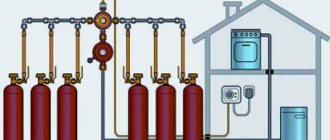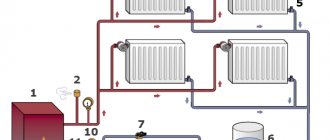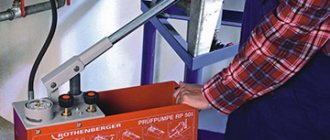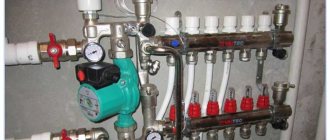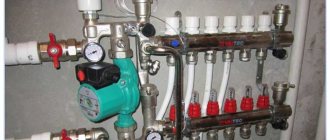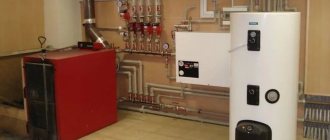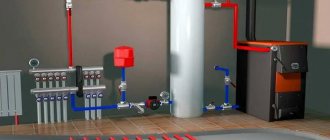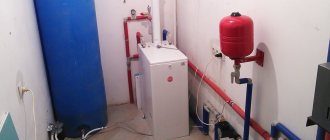The passage of a heating main with hot water near the place of residence is the prerogative of urban residents of apartment buildings; in country cottage villages, rural areas and dachas, the presence of a heating main laid nearby is very rare. An autonomous heating system helps solve the problem of heating a home in the cold season, which homeowners install in their home with the help of specialists from numerous companies or use the services of private craftsmen - doing the work yourself is problematic due to its high complexity and the need to use special plumbing tools.
Typically, individual houses are heated with heated water; due to its high heat capacity, it is the main type of coolant in heating systems; if it is necessary to take measures to protect against freezing of pipes, special non-freezing liquids (ethylene glycol, propylene glycol) are used in the system. Heating of liquid coolants is carried out using heating boilers operating on various types of fuel. The main task of the owner when choosing a heating method is to select the optimal type of fuel and boiler from the point of view of ease of use, minimizing costs during installation and operation, reliability and durability of the system.
Rice. 1 Autonomous heating system and example of boiler connection
It may be useful to read about Connecting the boiler to the heating system
Pros and cons of autonomous heating
Autonomous heating primarily means independence from various factors, natural conditions and organizations that are, to one degree or another, associated with the sale of heating services or heating materials in a given area. The advantages of individual heating are:
- Selecting heating equipment and fuel type that is suitable for your financial capabilities and ease of use.
- Possibility to set the start and end of the heating season at your discretion.
- Adjusting a comfortable temperature not only throughout the house, but also in individual rooms.
- When designing, the advantage is that it is possible to place heating radiators at your discretion, remove or install one or more than one section on them to optimize heat transfer. You can lay heated floors, choose the boiler power and the parameters of the entire heating system within a wide range, regardless of the characteristics of the external heating main, the official connection to which is subject to some restrictions.
- If you are away from the house for a long time, you can completely turn off the heating or set it to operate in economy mode.
- The use of double-circuit systems in an individual home allows not only to heat buildings, but also to heat cold water to a high temperature for use in everyday life and for personal hygiene purposes.
Rice. 2 Autonomous heating system in a private house - a variant of the heating and hot water supply scheme for DHW
- The use of solid or liquid fuels, which are stored in certain quantities, makes the heating system completely independent of external communications - gas pipelines, heating mains, and allows you to heat the house without being tied to emergency situations on engineering routes outside it.
Despite its many advantages, autonomous heating has quite significant disadvantages, the main ones being:
- Operation, maintenance and monitoring of an autonomous heating system takes up a lot of free time and requires some physical effort when using solid fuels.
- The main disadvantage of individual heating is the high cost of purchasing and installing equipment: a boiler, heat exchange radiators, manifold junctions and piping systems for underfloor heating, circulation electric pumps, plumbing fittings (air vents, check valves, shut-off valves and ball valves), automatic control.
- After installing the system, fuel costs also take up a significant part of the budget; many homeowners cannot afford to pay for the energy consumption of an electric boiler.
- During installation, additional costs will result in changing the configuration of walls, partitions and floors for laying pipelines, and installing screeds for heated floors.
- When using natural gas from the central pipeline as fuel, permission from the relevant services is required, and obtaining it is a long-term, complex and tedious procedure that requires the investment of significant sums of money.
- Financial resources will also be needed to ensure contractual obligations with organizations involved in the maintenance and repair of installed equipment and service center specialists.
Rice. 3 Operating principle of a closed heating system
Diesel Sheet Metal Heater
From the outside, diesel stoves for a metal garage look like two disks joined together by a tube with a large number of holes and an outlet pipe for combustion products on top. The device is assembled from two containers, which are connected to each other with a wick bowl, in other words, a wide pipe with holes for air supply and smoke exhaust.
The diesel fuel enters the wick container from the fuel tank on its own. In it, diesel fuel is heated and converted into a mixture of gas and air. It enters the combustion chamber, where it ignites. A spiral placed on top of the firebox acts as a heat exchanger. It can heat up to 800?. The waste is discharged through a chimney.
This design is safe, economical and does not harm the external environment. Assembly requires 2 metal sheets of 5 mm. The chimney is installed far from the door, it has two elbows nested inside each other. The container located below is the combustion chamber and the fuel tank. Fuel is poured into it through a hole. Capacity volume – from 2 to 12 liters.
Autonomous heating system - operating principle and main components
Any autonomous heating system includes the following main components:
Heat generator. It is a device that converts electrical or energy from burning fuel into heat, while the heat generator simultaneously transfers thermal energy to the coolant. Two main forms of the environment are used as a thermal carrier - air masses and liquid. Most often, purified distilled water is used in heating systems, which has the highest heat capacity coefficient, that is, the ability to transfer and accumulate energy; all other liquids, including non-freezing antifreeze, are significantly inferior to water in this indicator.
To convert fuel into thermal energy and transfer it to the carrier, the process of combustion occurs in heating boilers; if electricity is used, the heating of the coolant medium is carried out by heating the material with high electrical resistance to alternating current and its mutual heat exchange with the working fluid.
Heat conduction line. The coolant heated in the boiler is supplied to the heat exchange devices through pipes. Previously, steel pipelines were widely used (less often copper due to high cost), with the development of the chemical industry, steel is gradually being replaced by pipes made of polymers: PPR polypropylene, cross-linked polyethylene and PEX metal plastic.
Polymer pipes, due to their flexibility and elasticity, made it possible to install multi-circuit heated floors with water heating in buildings, which was impossible to do with metal pipelines.
Heat exchange devices. The coolant from the boiler flows through pipes into heat exchange devices, which in most cases are radiators; the liquid passes through them and transfers heat to the air due to the large area of the heat exchanger body. To increase or decrease thermal output, it is possible to change the battery configuration by adding or removing individual sections; the radiators are made of steel or aluminum, which have good heat output (high thermal conductivity).
Rice. 4 Air convector - operating principle
Security measures
It is necessary to pay attention to the fact that when installing a diesel stove, it is necessary to take into account safety rules and advice from professionals:
- the length of the chimney must be at least four meters;
- instead of diesel fuel, the use of used oil is allowed;
- the oven requires periodic cleaning - every 14 days with constant use;
- for kindling you need a rag soaked in diesel fuel or a piece of newspaper - it must be set on fire and placed in the firebox, the rest of the fuel will ignite when the desired temperature is reached;
- the heated room must be protected from drafts, but good ventilation must be ensured;
- toxic combustion products appear only during the ignition process - a specialized outlet can be built for them;
- The stove must be installed at a distance from flammable objects to avoid fire;
- There must be at least 50 cm of free space around the stove on each side.
Autonomous heating system with air convectors
An autonomous air heating system usually involves the use of electric convectors, the built-in fan of which supplies air to the heating elements, after which it enters the room. Air conditioners operating in heating mode, and ordinary cheap electric heaters without fans with an open spiral, or oil heaters, where the heating element is immersed in the coolant, can heat the air. The latest technology is the use of energy-saving air-to-air heat pumps for heating; the thermal energy obtained as a result of their operation is transferred to the air masses and distributed throughout the entire area of the room due to built-in fans.
Heating rooms with heated air is not a very popular method among consumers and has the following features:
- All air heating options allow you to heat a room in a short time, unlike water heating, which requires significant time intervals to start supplying heat.
- Electric convectors with an open spiral burn oxygen - this worsens indoor air quality and can cause headaches.
- If one convector is used to heat several rooms, you will have to install a bulky air duct system and suspend it from the ceiling.
Rice. 5 Heating with air conditioners
- In addition to heating, a high-tech heat generator (air conditioner) is capable of performing the functions of humidifying, filtering or cooling air during the warm season.
- The heating installation and ventilation ducts are not at risk of defrosting during the cold season, as well as leakage of the coolant in the system, which is air.
- Air heating is easy to implement in any room of large or small area; in the simplest case, it is enough to connect the convector to an outlet to receive heat.
In addition to small heat generators running on electricity, stationary large heat generators running on gas or liquid fuel are used for air heating; their main components are (Fig. 7):
- Gas burner placed in a large volume container (housing).
- Combustion chamber in which gas combustion occurs and its thermal energy is transferred to the air.
- A system of fans providing air exchange and supply of heated air into the air ducts.
- Air duct hoses that direct the flow to different rooms.
- Electronic automatic control and monitoring system with setting the operating mode and temperature parameters of the convector.
Rice. 6 Autonomous heating system with heat pumps
Where to buy an autonomous car interior heater
Purchasing devices today is not difficult. This can be done right from home by ordering the model you like in online stores. Here you will find a wide selection of products from various manufacturers, real customer reviews and ratings.
Autonomous vehicles are also sold in specialized stores. Before purchasing, it is advisable to study the connection features of a particular device and the power of the heater. It is better to entrust the installation to specialists.
Today, the technical component of car engine heating devices has become much more advanced. Previously, heating the engine while idling was considered the only effective way. It had many side, negative consequences. Block heaters are a little better suited for modern motorists, since they are quite simple in design, equipped only with a connector and a heating element. There is no other unnecessary equipment here. But the long heating time and the need for a stationary 220 V socket completely deprive them of their advantages over “autonomous” ones. The same can be said about heaters with heating plates, remote and pipe electric heaters.
Types of liquid autonomous heating systems
Heating systems for heating an individual home using water and non-freezing liquids (antifreeze) as a coolant differ in a number of ways, the main differences:
By type of fuel used . The most popular types of energy for heating coolants are electricity, gas, liquid flammable hydrocarbon mixtures (diesel fuel, fuel oil, oil, kerosene), a large number of solid combustible materials - firewood, coal, peat briquettes and pellets of various compositions. Electricity can be obtained either from energy companies or independently using solar panels, wind or hydraulic generators.
By type of thermal generators . In modern heating systems, heating boilers are used to transfer energy to the coolant, which have design features and differences between analogues for each type of fuel. With a lack of funds, many craftsmen assemble autonomous heating with their own hands, using self-assembled structures, mainly solid fuel, instead of factory boilers, a typical example is a metal stove in a living room with an expansion tank in the attic and a steel piping system with radiators.
Step-by-step instructions for beginners
Having no experience in matters of autonomous heating, it is better to give preference to electricity. Although the energy bill can boggle the mind, significant savings arise due to the ease of installation and operation of the device.
In any case, the development of the project and its implementation is carried out according to the following scheme:
- Calculate or order a heating system calculation from specialists.
- Add at least 20% margin to the calculated number of radiator sections. This will allow them to be used effectively throughout their entire service life, when the internal surfaces become coated.
- Radiators are being installed.
- The boiler is being installed.
- Pipes are run from the boiler to the radiators.
- Upon completion of installation, the system is tested for leaks.
If installation skills are not enough, it is better to invite an experienced locksmith, since you cannot allow the house to be flooded with hot water in winter.
Boilers for water autonomous heating - types and features
Heating boilers are the most used equipment in the private sector, with their help they not only heat houses, but also heat cold water for household needs and personal use for hygiene purposes, using double-circuit modifications. Factory-made boilers are distinguished by their reliability and long service life, relatively affordable price, efficiency and comfortable operation; when installing simple collectorless heating systems with radiators only, it is possible to install all the heating equipment yourself. When choosing a boiler, they are primarily based on the cost and availability of fuel; their main options are discussed below.
Autonomous heating with gas boilers
Today, gas autonomous heating is the undisputed leader in prevalence due to the low cost of gas and a developed network of gas pipelines.
Gas heating has the following features:
- Lowest fuel costs compared to other types of fuel boilers.
- The cost of a typical boiler is higher than that of similar equipment of other types; its average price is about 42,000 rubles.
- The equipment requires regular maintenance by service specialists; before its installation, numerous approvals must be made with gas services.
- The gas is explosive, therefore, during installation and operation, special attention should be paid to the reliability and tightness of connections.
- When gas burns, oxygen is consumed, so good ventilation must be provided where the boiler is located. The product of combustion is soot, which settles on the inner walls of the chimney - this requires the use of measures to periodically clean it.
Rice. 10 Gas boiler - main components
Autonomous solid fuel heating system
Solid fuel boilers are classics and rank first in popularity in areas where there is no centralized gas supply; solid fuel heating has the following features:
- The cost of boilers is the lowest among all analogs; the average price of a standard model is about 17,500 rubles.
- Fuel is available in all areas of the country; in coal mining areas, coal is naturally used more often than other varieties; in the middle zone, peat briquettes, eurobriquettes, firewood and wood waste, and pellets are popular.
- Storage of solid fuel requires a certain place; its storage and use takes up a lot of free time and requires constant cleaning in rooms with boiler equipment.
- The products of combustion are soot, which, when released into the air, settles on the surface of the earth, polluting the environment and atmosphere.
- Due to the large amount of soot in pipelines and chimneys, they require regular cleaning of sediment; if this procedure is not performed or there are delays, there is a high probability of soot ignition, leading to fires.
Rice. 11 Solid fuel thermal generator - operating principle
Autonomous liquid fuel heating system
Liquid fuel heat generators are not as common in everyday life as gas and solid fuel equipment; unlike domestic consumers, this type of heating is highly popular among residents of Western European countries. Features of heating buildings using liquid fuel boilers are the following factors:
- Diesel fuel, kerosene, gasoline, and waste vegetable oil can be used as fuel.
- The average cost of a domestically produced low-power liquid fuel boiler is about 30,000 rubles; the price of imported models can exceed this amount by 10 times.
- All boilers are characterized by high operating efficiency (efficiency), which averages 92%; 1 liter of fuel per hour is consumed to produce 10 kW/h of thermal energy.
- The power of manufactured products lies in a wide range and is designed for heating from one-story small residential buildings to large production workshops.
- Almost all boilers operating on liquid fuel can operate on natural gas.
- Thanks to the built-in automation system, human presence is not required when operating the equipment.
- When a gas connection is not used, installation of the boiler does not require permits from the relevant organizations.
- The equipment is characterized by high autonomy; if electricity is required for operation, it is obtained by burning the same fuel in an electric generator.
- Fuel has a high cost, so operating the boiler will cost more than other types.
- To store fuel reserves, it will be necessary to erect a separate outbuilding or shed; under it, containers with fuel should be placed in the ground to protect from the sun, which reduces its characteristics.
- To install the unit in a house, you will need a separate room equipped with powerful exhaust ventilation, since the burner makes noise during operation, the room will need to be soundproofed.
Rice. 12 Liquid fuel boiler - main components
Autonomous heating system using electricity
Electricity is the simplest and most accessible type of energy, which can be obtained both from state power lines and independently, using the energy of the sun, wind, moving water; in electric generators, electricity is obtained by burning liquid fuel. Electric boilers are quite different from similar units in the following properties:
- The average cost of a typical household boiler is about 35,000 rubles.
- The equipment operates reliably and silently.
- During operation, no harmful substances are released into the atmosphere; installation of air ducts and chimneys is not required, or the installation of special exhaust systems to renew the air in the room.
- The service life of the main tubular electric heating elements (TEHs) does not exceed 15-20 years.
- Operation does not require human intervention; electronic programming of the system is possible, in which the boiler will operate independently for many months.
- The equipment is sensitive to surges and sudden power outages, in this case nothing will happen to the heating elements (resistive elements are not sensitive to energy changes), but the automation may fail.
- In areas with unstable power supply and frequent accidents, the use of an electric boiler is problematic - if there is a long absence of electricity and the boiler is turned off, the pipeline with the coolant may freeze.
- Installation and assembly of the electric boiler does not require approval from the relevant services.
- High electricity tariffs prevent the widespread use of such an electric heating system in everyday life.
Rice. 13 Electric boiler - device
You might be interested: Do-it-yourself heating in a private house from polypropylene pipes
Rating of the TOP 5 best models of autonomous vehicles and their technical characteristics
The most popular among domestic car enthusiasts are the 5 devices presented below. These are models from German, Austrian and Russian companies.
Webasto Air Top 2000 ST
High-end air heater designed for installation in trucks, cars, minibuses, ambulances and campers. Fully autonomous, operates independently of the internal combustion engine. Connects to the fuel tank and electrical system of the car. Approved for use in liquid and air cooled vehicles. In summer it can be used as a fan.
Installation of this “wet autonomous system” is possible both inside and outside the car. The device must be protected from accidental touches, so it must be placed within hand reach.
Webasto Air Top 3500
Autonomous heater designed to create maximum comfort in sleeping areas, truck cabs, as well as minibuses and motorhomes. It runs exclusively on diesel fuel, although gasoline versions were available for some time (small series).
Installation is carried out through a special gasket so that there is no integration with the body. The surface under the base itself must be flat.
HYDRONIC B4W SC
Gasoline or diesel heating 12-volt device designed for installation in all types of vehicles. Connects to the cooling system. Heats the driver's cabin, cargo areas, engines and vehicle components.
The device is installed horizontally in the engine compartment, always below the minimum coolant level. This is necessary so that the heat exchanger is deaerated automatically.
Eberspächer Airtronic D2
Diesel air heater with a power of 2.2 kW. Designed for installation in small vehicles. Provides comfortable heating of the interior without starting the engine. In addition to autonomous operation, the advantages of this heater are: low fuel consumption, low noise level, the ability to choose between 12 and 24 volts.
The installation of this device is greatly simplified due to the presence of electronic controls. As a rule, it is mounted in the trunk or interior of the car, rarely under the floor.
Planar 4D
Independent of the car engine, this air heating device runs on diesel fuel. Forced heating of the flows in the heat exchange system is ensured. The heat source is gases formed from the combustion of the fuel mixture.
At the buyer's request, it can be equipped with a remote sensor. The required temperature is regulated within 15-30 °C. The device must be installed so that the heater inlet does not suck in exhaust gases from the internal combustion engine and heater. It is also necessary to provide protection against the ingress of foreign objects.
Criteria for choosing a boiler for autonomous heating of a private house
When choosing the type of boiler for heating, there are no alternatives only if gas is supplied to the house; it is the cheapest type of fuel and, in comparison with other sources (electricity is not considered), has a number of operational advantages - it does not require space for storing reserves, highlight There are fewer combustion products released into the environment and does not pollute the chimney system as intensively.
The main parameters that people pay attention to when choosing a boiler are:
- Unit power: directly related to the area of heated premises and temperature conditions, which are usually chosen based on building codes and GOSTs.
- Number of circuits: if the house does not have hot water supply, it is more practical to choose a dual-circuit model that can heat water.
- Location: usually the unit is installed downstairs in the basement on the floor; there are also hanging options for small houses.
- Material of manufacture of the unit and heat exchanger: cast iron, stainless steel, copper.
- Type of combustion chamber according to the method of supplying air to the firebox: open or closed.
- Availability of automatic control and monitoring systems, possibility of programming operating modes.
- The ability of the boiler to work with alternative fuels: relevant for liquid fuel modifications.
Which one to choose: 12 volts or 24
As a standard, 12-volt heaters are suitable for passenger cars, minibuses, and small vans, and a 24-volt autonomous interior heater is used for trucks and large equipment. However, you can take a 12-volt model into a 24-volt car, but with a converter. Buying the other way around is not recommended!
12-volt auxiliary heaters have recently been increasingly made from ceramics. They do not dry out the air in the cabin, heat up quickly, are economical, and are equipped with overheating protection. Such devices weigh no more than a kilogram and can be easily transported to the desired location.
Selection of a boiler for autonomous heating by power
The passport data for the boiler must indicate its rated power; sometimes the manufacturer gives the area of the premises in square meters that a given boiler can heat. For average calculations, we take the consumption of 1 kW of thermal power of the unit to heat 10 square meters of living space with a ceiling height of 2.5 - 2.7 m. If the height is greater, a correction factor is introduced, for example, the power is multiplied by 1.23 at a distance from the floor to the ceiling 3.2 m.
Also, the calculations take into account the climatic zone in which the house is located; it is included in the formulas in the form of a correction factor and ranges from 0.7 for the southern regions to 2 when housing is located in the northern regions. If a double-circuit boiler is used to heat water, its design power is increased by 20 - 25%.
To determine the power of a heat generator, SNiP 2.04.07-86 is sometimes used, according to which for low-rise buildings, if the average external temperature is -25 ° C, heat consumption is calculated according to the standard 173 - 177 W / m2, and in high-rise apartments the standard is taken to be 97 - 101 W/m2.
To summarize, it should be noted that for approximate accelerated calculations taking into account various factors (hot water supply, high ceilings, cold climate), a boiler is usually selected with an average power, which should be about 1.5 kW per 10 m2 of room.
Rice. 16 Example of calculating thermal power
Precautionary measures
The use of homemade diesel stoves is always associated with the presence of an open fire. Therefore, certain precautions must be taken. They will help you avoid many troubles and even tragedies.
Garage stove
These precautions are fire safety measures:
- the stove must not be installed in places where drafts are possible (they contribute to the activation of combustion of the mixture);
- It is necessary to create a space around the stove (approximately 1.5 meters) free from combustible and flammable objects (this must be especially ensured in a garage or workshop);
- provide access to a fire extinguisher;
- the length of the chimney must exceed 4 meters;
- After using the stove, it is necessary to carry out its cleaning and maintenance;
- For residential premises, it is advisable to use factory-made diesel fuel stoves that have special permitting certificates.
Stages of installing a heating system with your own hands
Installing a simple heating system in a house with your own hands without manifold wiring and laying heated floors is a task that many homeowners can do if they have simple construction and plumbing tools. For efficient and high-quality work, you will also need knowledge of the boiler installation diagram (instructions to help), technologies for installing various types of pipelines, special skills in soldering or welding pipes if a polypropylene or steel pipeline is selected. Do-it-yourself installation of an autonomous heating system in a private house or apartment from A to Z is carried out in stages in the following order:
- They independently draw up or order a heating scheme from an architectural organization, taking into account the design features of their home, and the construction of a well for connection to the gas pipeline.
- Determine the type of fuel and boiler that will be used to heat the premises, its configuration (double-circuit or single-circuit).
- Select the material of the pipes if you plan to hide them under the floor when connecting them to heating radiators; purchase products made from cross-linked polyethylene PEX of a suitable diameter. Their undeniable advantage is flexibility, the ability to interconnect and connect to heating equipment using compression fittings that do not require special crimping or soldering plumbing tools.
If the pipeline is laid over a surface, you can use polypropylene, steel or copper pipeline, the elements of which are connected by soldering or welding.
- The type of heat exchange devices is selected, calculating the number of radiators and the required battery power in accordance with the area of the heated premises and the optimal temperature in the premises; the number of sections is calculated manually or using calculators.
- They decide on the connection diagram for their batteries; it can be one-pipe or two-pipe; the best results are shown by the accompanying two-pipe wiring, which ensures the same heating temperature for all radiators connected to the line.
Rice. 17 Gas boiler for autonomous heating - installation option
- They begin installing the system by installing the boiler on the floor in the basement and hanging it on the wall, after which through holes are drilled in the walls and a pipeline is installed; if the heating pipes are located in the floor, grooves are cut in the screed into which the pipe line is laid.
Grooves are also made in walls if the pipeline is running along the surface and they want to hide it to improve the aesthetic appearance.
- Radiators are hung on the walls, to reduce heat losses, a foil film is placed behind them to reflect infrared radiation, and a heating pipeline is connected to them.
- The system is filled with water and checked for leaks; for this, the liquid is supplied under pressure 1.5 to 2 times higher than the working pressure (pressure testing) and the system is left in this position for 30 minutes to 24 hours.
- Turn on the boiler at a low temperature and check the heating of all radiators, using the Mayevsky taps built into the batteries to remove air pockets that interfere with circulation and heating. After de-airing the entire system, turn on the boiler at full power and sequentially check the functioning of the system under different operating modes, changing the flow rate on the circulation electric pump.
- The final stage is balancing the system in order to achieve the same heating temperature for all radiators; for this, thermostats are usually built into them before installation and the user can only check their correct operation with a thermometer.
Fig. 18 Solid fuel boiler with a capacity of 20 kW in the basement
Oven characteristics
All types of autonomous diesel stoves can be divided according to the following criteria:
- heating method;
- design diagram;
- allocated power;
- diesel fuel consumption rates;
- possibility of connecting additional heating devices or systems;
- weight and size characteristics.
Potbelly stove
Based on the heating method, they can be divided into two large categories:
- autonomous devices using direct heating;
- devices using indirect heating.
A feature of direct heating devices is the absence of an equipped chimney. They are called "potbelly stoves".
Indirect heating devices are most widespread.
A homemade diesel stove is assembled according to one of the following schemes:
- double-circuit or as it is called gas-air;
- wick;
- drip;
- using steel sheets;
- using an ordinary gas cylinder.
Homemade diesel stove
In terms of heat output power and diesel fuel consumption rate, factory-made units start from 2.5 kW with a consumption of 180 milliliters of diesel fuel per hour and up to 20 kW with a productivity of 550 m3 per hour. Diesel fuel consumption increases to 1.5 liters. Such units are called heat guns.
Possibility of connecting additional heating systems, such as air ducts. Depending on the characteristics, the continuous operation time changes. This time varies from 6 to 28 hours of operation without refueling.
Registration of permits for the installation of autonomous heating
To install an autonomous heating system in a country house, you will have to contact the rural or city administration at your place of residence, since the installation of such a system is a reconstruction or redevelopment of the premises, you will need the following documents:
- Application in the approved form, which is specified in Government Decree No. 266 dated April 25, 2005.
- Certificate of ownership with accompanying documents: state registration, agreements of donation or transfer of ownership of housing, notarized right of inheritance.
- With shared participation, confirmation of real estate ownership will be required from all owners and their consent to install the system (signature of all residents on the application).
- A photocopy of the technical passport of the premises.
- Confirmation by architectural authorities and organizations involved in the protection of monuments, the status of housing - whether it represents architectural, historical or cultural value.
- A project for installation or redevelopment, consisting of a plan for the placement of a gas pipeline and the installation of a boiler.
- When installing a powerful electric boiler (if the value exceeds 30 kW), you will need a copy of its passport with confirmation of the maximum power, and a power supply agreement.
- A home renovation project (moving or dismantling internal partitions, walls, door and window openings), if it occurs during the installation of equipment. It is compiled by the design organization; the documents contain basic information on the installed system and technical calculations. Design solutions are also coordinated with fire services, sanitary and epidemiological stations, and gas workers.
- Technical conditions for connecting the gas main (issued by gas distribution government organizations or private owners of fuel and communications), ventilation devices in the room with the boiler.
This package of documents is submitted to the interdepartmental commission responsible for the operation of the housing stock and located in the administration; you should expect a response in about 45 days.
After the connection and installation of networks by the relevant services, an acceptance certificate is drawn up, a copy of which is submitted to the real estate registration service.
Rice. 19 Installed liquid fuel boiler
Radiator from a gas cylinder
To assemble such a diesel stove you will need:
- seamless balloon with a wall thickness of up to 1.5 cm;
- fuel capacity 8-15 l;
- smoke exhaust pipe 4 m long and with a cross-section of 10 cm;
- copper tubes for burner assembly;
- steel corners 20 cm;
- inverter and angle grinder.
The diesel fuel will flow into the furnace on its own without forced air injection. The size of the outer contour of the stove must be suitable for the height of the flame so that the device does not heat up to excessively high temperatures. The walls of the device do not have to be very thick for the hot vapors generated to reach a specific temperature. An empty gas cylinder must be divided into 2 parts - the upper one will serve as a lid, and the lower one will serve as a firebox.
On the side, to the part located at the bottom of the cylinder, you need to attach the legs from the corners. On the other hand, stepping back 10-15 cm from the edge, you need to cut a hole for the chimney using welding. A pipe with a cross-section of 10 cm and a length of 4 m is suitable for this. It must be attached clearly at an angle of 90° to the body. You need to cut a hole in the chimney to regulate air access and cover it with a plate.
Stepping back 10 cm from the welding point, cut a small hole of 2-3 mm. Next, retreating 5 mm each time, you need to make 9 more similar holes - the last one will be placed 50 cm from the welding point. Moreover, another hole is made in the pipe for a pipe with a cross-section of 5-8 cm and a length of 2-4 m. It is welded parallel to the floor. A hole with a cross section of 5-8 cm is cut in the top of the cylinder for fuel supply.
Diesel heating supply for garage and universal: making a choice
Diesel heaters for garages are not uncommon these days. After all, many people spend a lot of time near the car, and when it’s cold outside, this is simply a necessity. However, a diesel heater for a garage will not always be productive, because the price of heating is not unimportant.
Today we will talk about what kind of diesel stoves there are for the garage, where they should be used and how much better it will be. There are many videos and photos on this topic; today we will analyze this type of heat supply.
Alternative to autonomous heating
Taking into account the specifics of the operation of premises for keeping poultry, we can say that, no matter which of the autonomous heaters described above is chosen, the factor of the presence of animals complicates the use of the units.
It is advisable to solve the problem in a different way: use an electrical device that is suitable in design and affordable in price as the main means of heating, and have an autonomous device in case of emergency situations.
For example, an electric infrared heater for a chicken coop is the best option for the main heater, but lamp emitters with high surface temperatures should be inaccessible for direct contact.
Infrared electric heaters of lamp design
IR rays affect obstacles along the path of their propagation - they increase the temperature of their surface, after which the heated interior gives off heat to the surrounding air. In this case, infrared radiation has a thermal effect directly on the bird, but the parameters of the transit medium - air - do not change during passage.
In small chicken coops, lamp IR heaters are placed closer to the perches, since increasing the distance to the emitter reduces the heating intensity.
A variety of infrared heaters - film devices also cope well with the task of heating chicken coops, both small and large. At the same time, the low temperature of the radiating surface makes them safe for direct contact with birds or humans.
Film infrared heaters on the ceiling in the poultry house
In winter, the temperature in the chicken coop should not fall below 10 0C, which can be ensured by installing an external thermostat. Based on the permissible temperature value, in central Russia the room does not require high-intensity heating. Consequently, monthly energy costs during the winter period will not be significant.
Top 6. Warmtoo All in one
Rating (2021): 4.60
433 reviews taken into account from resources: AliExpress
Multifunctional device This auxiliary heater has an LCD display and a sensor that analyzes the current temperature. Control via remote control is also provided.
- Characteristics
Average price: 12874 rub.
- Material: plastic, metal
- Dimensions and weight: 39*41.5*15.3 cm, 10 kg
- Fuel consumption: 0.1 l/h
- Claimed power: 8000 W
- Operating temperature: -40°C to +80°C
Warmtoo All in one is superior in functionality to all other heaters. There is a remote control as well as an LCD display. The device continuously monitors the engine heating process and displays diagnostic results on the screen. There is a function of automatic and manual temperature control. The seller offers more than 10 color options for the case. The kit is impressive, because it includes all kinds of fastenings, remote control, instructions, etc. However, you will have to buy batteries for the remote control. The main drawback mentioned in the reviews is that the temperature sensor slightly overestimates the readings. Also, AliExpress users complain about unreliable packaging.
Advantages and disadvantages
- Display with heating diagnostics
- Remote control
- Instructions in Russian
- Full set
- Bad packaging
- No batteries included
- The sensor overestimates the temperature
Buy on AliExpress.com
See also:
- 15 best batteries for winter
